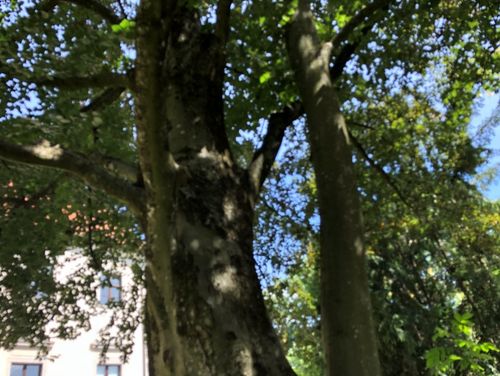In addition to the university pond, the Schloss Park is also a recreational area for JKU students, employees and local residents.
Sections of the Schloss Park could qualify as Linz' first botanical garden. The park contains an impressive variety of trees (sycamore, copper beech, slit-leaved copper beech, and Canadian hemlock). In February of 1994, the State Government's Office of Upper Austria even placed four of the sycamore trees under natural protection. In 1975, the Linz Municipal Council recognized a beautiful sequoia tree in the park area a natural monument.
Native throughout Central Europe, the copper beech (Fagus sylvatica purpurea) located directly in front of the entrance to Schloss Auhof is a part of the beech family (Fagaceae) and as part of that, another species of common beech (Fagus sylvatica). The copper beech is a mutation of the common beech. The leaves contain a very high content of red leaf pigments which turn the foliage blood red. These beech trees can grow to be very old; a 200-year-old tree is not uncommon. They can also reach a height of between 30 and 40 meters when cultivated as a tree, and they can grow up to 45 cm a year. This makes them one of the most rapidly growing tree species.

Once the trees are approximately 30 years in age, the copper beeches begin to flower and produce so-called beechnuts.These small nuts can be used for sowing purposes. One of the most interesting features about the "1990 Tree of the Year" is its reddish-colored leaves as it has a missing enzyme; only young trees have this particular enzyme. During the course of a year, the red color fades and as autumn approaches and foliage from all of the other deciduous trees begin turning turn more yellow-red, this tree's foliage becomes more green in color.
The Fagus sylvatica purpurea is not only one of the most popular deciduous trees on campus because of the way it looks, but also because it makes an important contribution to conserving nature as many species of native garden birds choose to nest among the tree's dense branches and foliage. In addition, many wild animals feed on the beechnuts. Beech trees are not only for enjoyment purposes, industries process beechwood due to its elasticity. Beech is very popular in the furniture industry. Other products include beech wood flour as well as beech wood chips used when smoking fish and meats.